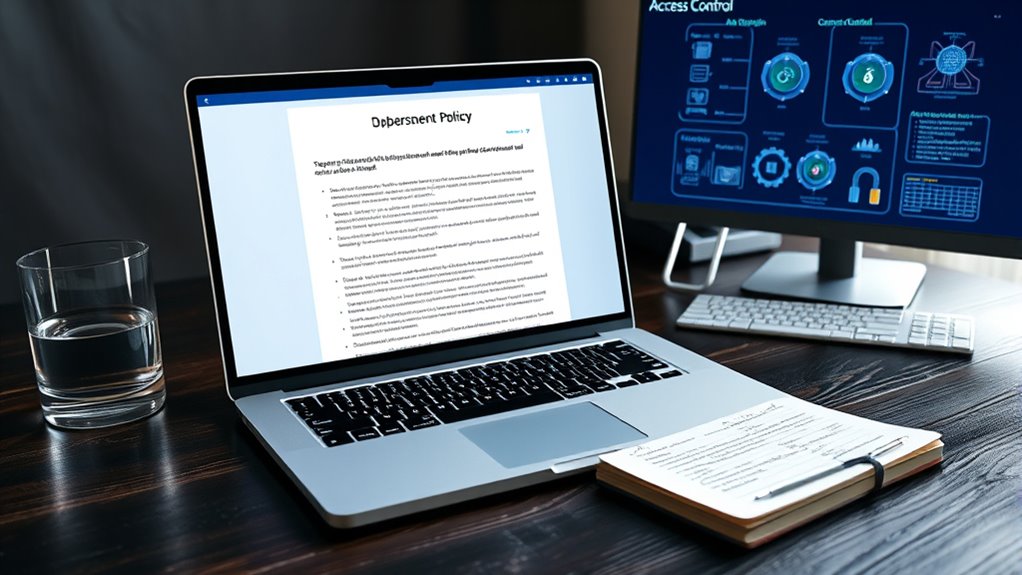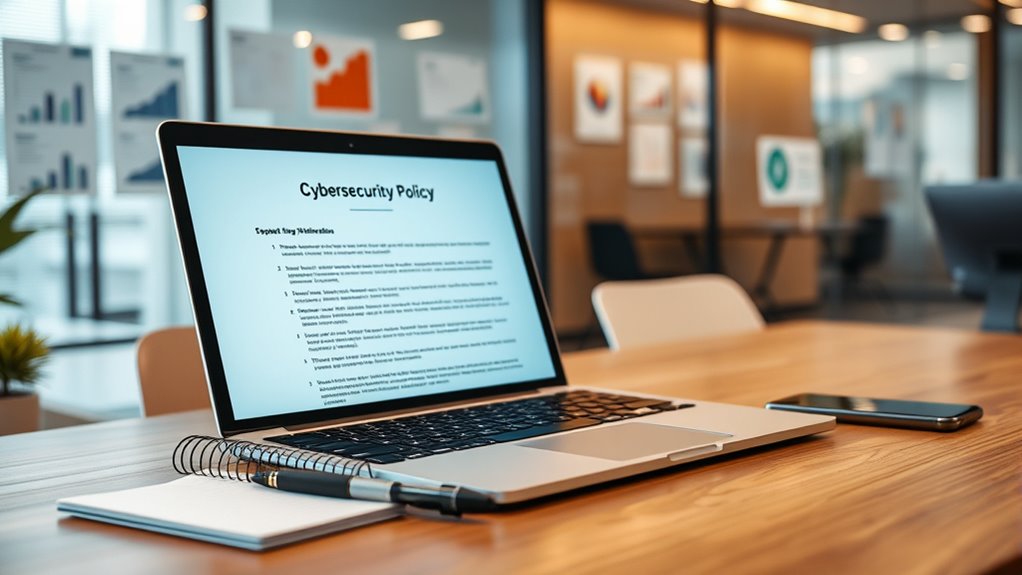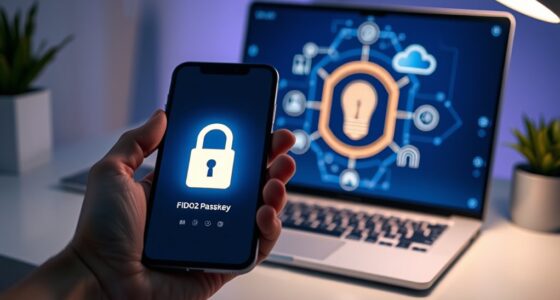To create a cybersecurity policy for your SMB, focus on key clauses like strong password, authentication, and access controls; data encryption standards; network security protocols; and employee training programs. Include incident response and regular policy reviews to keep defenses current. These elements guarantee your business stays protected from threats and complies with regulations. If you want to build a robust security foundation, exploring the details will help you implement effective safeguards.
Key Takeaways
- Essential clauses include password management, multi-factor authentication, and role-based access controls.
- Policies should specify data encryption standards and confidentiality measures for sensitive information.
- Network security protocols, monitoring practices, and incident response procedures are critical components.
- Employee training programs and regular policy reviews ensure ongoing cybersecurity awareness and compliance.
- Clear guidelines for device management, audit trails, and user permissions help safeguard organizational assets.
Essential Password and Authentication Policies

Are you confident that your organization’s password and authentication policies are robust enough to prevent unauthorized access? Implementing strong standards is vital. Ensure passwords are at least 8 characters long, but aim for longer passphrases with spaces and punctuation to boost security. Emphasize length over complexity, but include a mix of upper and lower-case letters, numbers, and special characters. Avoid common or simple passwords to prevent brute-force attacks. Enforce password changes every 90 days and prevent reuse through password history checks. Limit login attempts to deter guessing, and lock accounts after multiple failures. Incorporate multi-factor authentication for added security, especially for privileged or remote access. Educate users on secure password practices and use trusted password management tools to safeguard credentials. Implementing SMB security features like SMB signing and encryption further enhances overall organizational security. Regularly reviewing and updating your password policies ensures they stay effective against evolving threats.
Data Encryption and Confidentiality Measures

To protect sensitive data effectively, you need to implement robust encryption protocols and strict access controls. Ensuring confidentiality involves choosing industry-standard algorithms and maintaining secure key management practices. By consistently applying these measures, you can minimize risks and uphold data integrity across your organization. Encryption acts as a scrambler to secure data during storage and transmission.
Encryption Protocol Standards
How do organizations guarantee their data remains confidential and protected during transmission? They rely on robust encryption protocol standards. SMB encryption employs AES algorithms like AES-GCM and AES-CCM to secure data, ensuring confidentiality and integrity. SMB 3.0 introduced end-to-end encryption, safeguarding data as it moves across untrusted networks. Enhanced in SMB 3.1.1, encryption now includes preauthentication integrity and negotiated algorithms such as AES-128-CCM and AES-128-GCM. Additionally, TLS 1.3 and digital certificates are used to encrypt traffic, providing further security layers. SMB signing, mandatory in recent Windows versions, prevents tampering and MitM attacks. These standards collectively ensure that data remains confidential during transmission, reducing the risk of interception, eavesdropping, and unauthorized access over network connections.
Data Access Controls
Effective data access controls build upon encryption standards by defining who can view, modify, or transfer sensitive information. You should implement role-based access control (RBAC) to assign permissions based on job functions, ensuring users only access necessary data. Regularly review and revoke unnecessary permissions to uphold the least privilege principle. Enforce multi-factor authentication (MFA) to verify user identities with multiple verification factors, adding an extra security layer. Maintain strict user management by auditing accounts regularly, removing inactive or outdated profiles. Use Group Policy Objects (GPOs) to enforce consistent access policies across your network. Understanding SMB vulnerabilities By combining these measures, you create a robust framework that limits data exposure and reduces the risk of unauthorized access, safeguarding your organization’s sensitive information effectively.
Confidentiality Maintenance Practices
Maintaining confidentiality is essential for protecting sensitive information from unauthorized access or disclosure. You should implement data encryption for both data in transit and at rest, using protocols like SMB Encryption with AES-GCM or CCM, and full-disk encryption tools like BitLocker. Secure file sharing is critical—use encrypted cloud services or secure transfer protocols to safeguard data during transfer. Regular audits help identify vulnerabilities and ensure compliance with confidentiality policies. Additionally, enforce confidentiality agreements with employees and contractors to clarify expectations. Providing ongoing training keeps your team aware of confidentiality best practices. By applying these measures—such as network segmentation, strong firewall configurations, and secure protocols—you minimize risks and strengthen your organization’s data protection efforts. Enabling Multi-Factor Authentication (MFA) is also a crucial step in safeguarding access to sensitive information, as it significantly reduces the risk of unauthorized account access. Incorporating electric bike security measures, such as GPS tracking and secure storage, can further protect physical assets from theft or tampering.
Network Security and Access Controls

You need clear access authorization procedures to prevent unauthorized entry and protect sensitive information. Implementing effective network monitoring strategies allows you to detect suspicious activity early and respond swiftly. Protocols like HTTPS, SSL, and TLS are essential for secure data transfer and prevent interception by malicious actors. Additionally, establishing secure user authentication practices ensures that only authorized personnel can access critical systems, further strengthening your network defenses. Together, these controls form the backbone of a secure network environment you can trust.
Access Authorization Procedures
Implementing robust access authorization procedures is essential to safeguarding network security and controlling access to sensitive resources. You should use secure authentication methods like Kerberos and align SMB share ACLs with backend permissions to ensure consistency. Role-based access controls limit user permissions to only what’s necessary, reducing risk. Regularly review and update access policies, especially after organizational changes, to keep controls current. Manage user and group IDs carefully to ensure accurate authentication across systems. Follow a structured approach:
| Step | Action | Purpose |
|---|---|---|
| 1 | Implement RBAC | Limit permissions to need-to-know basis |
| 2 | Conduct regular audits | Detect unauthorized access |
| 3 | Enforce least privilege | Minimize potential damage |
| 4 | Update access policies | Adapt to organizational changes |
| 5 | Automate user account reviews | Maintain accurate access controls |
Additionally, ensuring that access controls are compliant with security best practices helps prevent unauthorized access and potential vulnerabilities.
Network Monitoring Strategies
Effective network monitoring begins with clearly defining your objectives and maintaining an accurate inventory of devices. Set goals for tracking device status, bandwidth, anomalies, and security events, focusing on critical infrastructure and endpoints requiring continuous visibility. Keep your network map and device inventory current to enable quick incident response. Establish measurable KPIs like uptime, latency, packet loss, and throughput, and review them regularly to address evolving threats and business needs. Select appropriate tools—SNMP, flow-based, or packet analysis—based on your network’s complexity. Use customizable dashboards and AI analytics for real-time insights, and establish baseline behaviors to detect anomalies. Ascertain tools are reliable, with automated discovery, segregated infrastructure, failover capabilities, and secure data storage. Regularly review and update your monitoring policies to maintain effectiveness. Additionally, understanding the Expiration of Vape Juice and other product shelf lives can inform policies on inventory management and security protocols for sensitive items.
Employee Training and Awareness Strategies

Employee training and awareness are critical components of a robust cybersecurity policy, as human error remains a leading cause of security breaches. You need to assess your team’s specific needs by reviewing surveys, past incidents, and role responsibilities. Customize training based on roles—basic awareness for admin staff and advanced topics for IT personnel. Regularly review and update your training to keep pace with evolving threats and organizational changes. Develop a structured, ongoing program that covers key topics like phishing, device security, password management, and data protection. Use varied methods such as videos, quizzes, and simulations to engage different learning styles. Conduct periodic assessments and gather feedback to measure effectiveness, reinforce knowledge, and address gaps, ensuring your team stays prepared against cyber threats. Incorporating Essential Oils for Cybersecurity can help create a calming environment that reduces stress and enhances focus during training sessions.
Incident Response and Recovery Procedures

How prepared is your organization to respond when a cybersecurity incident occurs? You need a clear, well-practiced plan. Start by identifying your critical assets, data, and systems to prioritize recovery efforts. Assemble an incident response team with defined roles, and develop tailored policies suited to your size and threat landscape. Conduct tabletop exercises regularly to test team readiness. Implement continuous monitoring tools to detect anomalies early and classify incidents by severity. Define immediate containment steps, such as isolating affected devices, removing malware, and applying patches. Develop recovery protocols to restore systems securely, validate their integrity, and monitor for recurrence. Keep stakeholders informed throughout the process, and after resolving the incident, conduct root cause analysis to improve your response plan. Additionally, regularly reviewing and updating your incident response procedures ensures your organization remains resilient against evolving threats. Incorporating training and awareness programs can further strengthen your team’s preparedness and response capabilities.
Regular Policy Review and Update Practices

Maintaining up-to-date cybersecurity policies is essential for staying ahead of evolving threats and ensuring compliance with changing regulations. Regular reviews keep your policies aligned with the latest technology and emerging risks, minimizing vulnerabilities. They also help you stay compliant with industry standards and legal requirements, avoiding penalties. By continuously evaluating risks, you can adapt your defenses based on lessons learned from incidents. Updating policies keeps employees informed about new threats and best practices, strengthening your overall security posture. SMBs face unique cybersecurity challenges that evolve rapidly, making regular policy updates crucial. Incorporating cybersecurity best practices into your review process can significantly enhance your defenses against sophisticated attacks.
Frequently Asked Questions
How Can SMBS Effectively Prioritize Cybersecurity Investments With Limited Budgets?
You can effectively prioritize cybersecurity investments by focusing on the most critical areas like data protection and employee training. Leverage managed service providers to access advanced security tools affordably and guarantee 24/7 monitoring. Use cost-effective solutions like antivirus software, firewalls, and VPNs to build a solid defense. Regularly update your security strategies based on emerging threats, especially remote work vulnerabilities, to maximize your limited budget’s impact.
What Specific Regulatory Compliance Requirements Should SMBS Consider in Their Policies?
You need to take into account specific regulatory requirements in your policies, like PCI DSS 4.0 if you handle payment data, HIPAA updates for healthcare, and SEC disclosure rules if you’re publicly traded. Also, comply with NYDFS cybersecurity guidelines and FTC Safeguards rules for financial data. Remember to stay current with state privacy laws, ensure data breach notifications, and regularly update privacy policies to meet evolving legal standards.
How Do SMBS Tailor Cybersecurity Policies for Remote and Hybrid Workforces?
You should tailor your cybersecurity policies by focusing on remote and hybrid work needs. Implement strong access controls, like role-based permissions and multi-factor authentication, to safeguard sensitive data. Use VPNs and secure communication tools for remote connections. Regularly update and monitor systems, and train your employees on cybersecurity best practices. Conduct risk assessments and practice incident response plans to ensure your team is prepared for potential threats.
What Metrics Should SMBS Use to Measure Cybersecurity Policy Effectiveness?
You should focus on key metrics like detection time, response speed, and incident rates to measure your cybersecurity policy’s effectiveness. Track how quickly threats are identified and contained, monitor the number of security incidents, and assess employee awareness and compliance. Regularly reviewing these metrics helps you identify vulnerabilities, improve response strategies, and make sure your security policies adapt to evolving threats, keeping your business protected.
How Can SMBS Foster a Security-Aware Culture Among Employees?
You might think building a security-aware culture takes too much time, but it’s essential for your SMB’s safety. Start by embedding cybersecurity into onboarding, regularly communicate risks, and lead by example. Offer engaging training, including simulated attacks, to boost awareness. Don’t forget, fostering open discussions about threats helps employees stay vigilant. These simple steps can transform your team into your strongest defense against cyber threats, saving you money and reputation.
Conclusion
By implementing these must-have clauses, you’re building a fortress around your business’s digital world. Picture a vigilant shield, constantly adapting to new threats, safeguarding your data like a locked vault. As you train your team and update policies regularly, you create a resilient barrier that withstands cyber storms. With each step, you’re not just protecting information—you’re anchoring peace of mind in a landscape of evolving risks, ensuring your SMB remains secure and confident.









